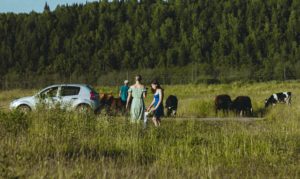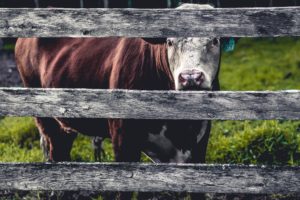Conflict abounds between farmers who want to protect their livestock and crops, and people wanting access to the countryside. AF examines both sides of the argument following the Labour party pledge to introduce a ‘Scotland style’ right to roam in England.
Git orf moi laaand!
There has long been a conflict between farmers and visitors over access to the countryside. This has been illustrated recently by the dispute over rights to wild camp on Dartmoor, which made it all the way to the Court of Appeal.
Frustration can boil over when visitors forget that the countryside is farmers’ working environment, and swift retribution has been seen in viral videos, like this one of a farmer moving a badly parked car from a gateway. Also, this one of a Cornish farmer muck spreading his headlands and a Mercedes car, which the owner had opted to park in his field.
In both cases the farmers garnered quite a bit of sympathy, although their methods are at the most extreme end of ‘direct action’.
Open to all
The campaign group Right to Roam say in their literature “We are excluded from hundreds of thousands of acres of open space – of woodland, meadows, rivers and their banks – simply because ancient laws of ownership fail to recognise the importance of nature to the public.”
This is factually correct, only 8% of the English countryside, plus any voluntarily opened areas, are accessible to walkers, horse riders, cyclists and other users. Based on the results of an NFU survey in 2021, we also know that 87% of people who visit farmland areas report improvements in their wellbeing. And crucially 84% said that their visits had helped them appreciate the role farmers play in creating and preserving the rural landscape.
Given the obvious benefits it seems odd that there is a conflict, farmers are not naturally a selfish bunch, far from it, so what’s gone wrong?
Irresponsible minorities
The conflict comes from irresponsible minorities on both sides. Frequently walkers suffer serious injuries caused by unfettered cattle near footpaths, with no signs or mitigation to protect them.
A Wiltshire farmer was fined £15,000 after his cattle attacked walkers and their dogs using a public footpath on two separate occasions. These incidents resulted in broken ribs, dislocated shoulder, broken vertebrae – serious injuries.
In another incident, in East Devon, a dog walker was thrown 8ft in the air and trampled by a cow as he walked on a public footpath where cows with calves were grazing. This victim also suffered broken ribs and spent 7 days in hospital as a result.
The HSE reports an average of two fatalities per year of walkers killed by livestock, most frequently caused by cows with calves, and bulls. This is on top of multiple serious injuries.
On the other hand…
Whilst there is no excuse for these incidents, and the farmers involved were successfully prosecuted, there is also a lack of understanding by some visitors as to how the countryside works. Two incidents of antisocial parking of cars have already been given, but there are many others, including a recent incident where a farmer shot a roaming pack of four dogs which were attacking his sheep.
Loose dogs are a common problem, more so since the rapid increase of households with dogs since the pandemic, particularly as many households don’t know how to train their new pets. A Buckinghamshire farmer was reported by Sky News to be losing one sheep a week to dog attacks last winter, and one major insurer paid out claims totalling over £1.8m last year.
And every farmer will have multiple stories of gates being left open, litter being dropped, footpaths being diverged from and petty theft from the workshop.
But let’s not forget that farm visitors are often the first to notice escaped stock, sheep on their backs, cattle trapped in fences, fly tipping, fires, vandalism and other mishaps. They are a valuable sentinel for farmers, who can’t be everywhere all the time.
Upping the ante
Now the Labour party have announced that right to roam is part of their manifesto, solutions need to be found. The Scottish model, that this pledge will emulate, allows a right to walk through the countryside, leaving no trace, with some exceptions such as not walking over land that is growing crops.
One answer is to widely publicise the Countryside Code and teach it in schools. It is long established and well known, but clearly not enough to stop the irresponsible minorities from making themselves a serious nuisance, and very unwelcome.
The Right to Roam campaign also endorses responsible behaviour, stating: “This right (to roam), however, is contingent on adhering to a strict set of responsibilities. These are simple, basic codes of how to behave in the countryside in such a way that you neither interrupt the function of a working, agricultural landscape, or damage the ecology of where you roam.“
And the answer?
As with most conflicts the resolution lies in an element of compromise. Clearly, access to our beautiful, rural, open spaces is of great benefit to everyone. Increasing the numbers of visitors may even increase our incomes, if farms can find a way to exploit higher visitor numbers. There will be another positive side effect in increased public knowledge of, and sympathies with, farming communities.
In return farmers must make sure that visitors remain safe, where mitigations and precautions can be taken. This means fencing, signing, and protecting those who are in an unfamiliar environment. A quick call to the AF General Inputs team will enable Members to source everything you require to keep yourselves and visitors safe.
In return we must ask that the HSE and DEFRA enlighten those visiting the countryside on how to behave, and inspire them to respect and appreciate the land and farmers, and inform them how to keep themselves and their pets out of danger.



